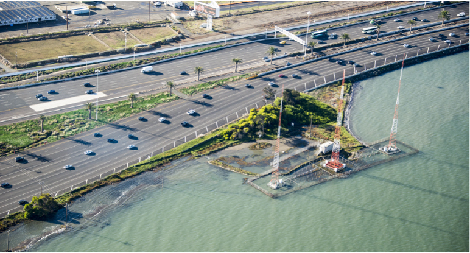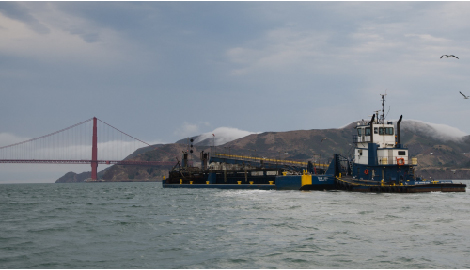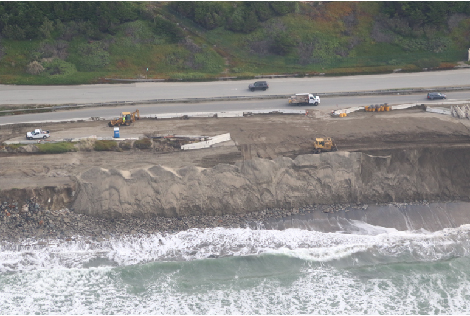
Protecting Cities & Natural Infrastructure Requires Bold Action
Sea level rise will have a significant impact on the Bay’s communities, economy, wetlands, pollution exposure, and recreational access. Baykeeper recommends the following actions to protect San Francisco Bay’s ecosystem and surrounding communities:
- Establish a region-wide approach to shoreline development that protects the Bay ecosystem, economy, and local communities. Empower a regional entity with the authority to regulate development and enforce these standards.
- Direct all healthy dredged sediment to wetland restoration sites. Modernize the regulation of sand mining and dredging in the Bay to account for coastal erosion, flood risk, and wetlands impacts.
- Implement green infrastructure throughout Bay Area cities and shorelines to prevent economic impacts and improve water quality.
- Create a regional plan that identifies and prioritizes contaminated shoreline areas and industrial sites for cleanup.
Sign up for Baykeeper's newsletter
Regional Planning Priorities
Sea level rise in the Bay Area is too consequential and the actions in one community impact neighboring communities are too interconnected for all cities to act independently. The region must embrace consistent policies and regulations for development and flood protection to achieve true resiliency. Here are some near term actions we can take:
- Update flood risk maps based on the Ocean Protection Council's 2018 sea level rise guidance.
- Expand BCDC's jurisdiction landward, to allow for consideration of future flooding, or increase its land-use authority, to allow for implementation of concrete and numeric planning requirements planning decisions in vulnerable areas.
- BCDC should identify appropriate land uses and building types in various vulnerable areas—based on updated maps and consistent with official State guidance—and ensuring uplands are available for marsh migration.
- Discourage development in flood zones—based on a risk framework such as that used in England—and require that communities shall not exacerbate flood risk in neighboring communities with flood walls and fill.
- Follow Maryland's example, which in 2008 passed the Living Shorelines Protection Act, leading to Living Shoreline Regulations, effective since 2013. These regulations state: "Improvements to protect a person’s property against shoreline erosion must consist of marsh creation or other nonstructural shoreline stabilization measures, i.e. Living Shorelines, that preserve the natural environment unless a Waiver is obtained."
Require responsible region-wide planning and development
The Bay Area needs a clear set of planning and development strategies to prepare for sea level rise.
Proposed developments near the waterline should be rejected or redesigned to accommodate rising water levels. Near-shore land use and urban planning should be required to include planning for sea level rise.
Moreover, these rules should be applied in all cities and counties, so that Bay Area communities are working collaboratively for the region, not competing against each other. And to oversee implementation, a regional entity must be granted authority to enforce these requirements.
In 2010, the San Francisco Bay Conservation and Development Commission (BCDC), attempted to include greater consideration of sea level rise in its decision-making process. Real estate interests and some shoreline communities strongly resisted granting BCDC the authority to regulate development to account for sea level rise outside of a narrow band along the shoreline.
Ultimately, BCDC's Bay Plan, which governs development along the edge of the Bay, was amended to incorporate sea level rise into the project approval process. But the plan’s language is vague and generally delays the hard decisions associated with adaptation planning and enacting strict regional planning rules.
Since then, local leaders and business interests have struggled to determine and implement appropriate development goals. This means city staff are left to decide individual development plans and projects without appropriate guidance and without a consistent set of regulations for the region as a whole.
Extreme weather events like Hurricane Sandy in New York have starkly demonstrated the potential devastation for urban areas unprepared for climate change and sea level rise.
Shoreline development needs to be managed carefully and at the regional level by an agency with appropriate authority. BCDC's existing regulatory authority is too narrow and existing guidance is too vague to make actionable decisions and local planners are seeking concrete guidance and requirements.
Baykeeper recommends that BCDC or another regional entity be given the authority to develop a consistent framework for planning and development along the Bay in order to ensure regional resiliency to sea level rise. A number of resources and examples are available yet more region-specific guidance is needed.

Stop misusing the Bay's sediment
Sand and mud are too valuable to be disposed of or mined at rates that far outstrip natural replenishment.
Sediment is critical to the healthy functioning of the Bay providing habitat for wildlife, ensuring healthy wetlands, and contributing to buffers against storm surges and sea level rise for shoreline communities. Marshes, mudflats, and subtidal habitats will require more sediment as rising waters push the Bay’s shores to higher ground. Yet currently, the Bay’s sand and mud are being misused or wasted.
Flows of fresh sand wash to the Bay from the Sacramento-San Joaquin Delta. Scientists have demonstrated that this sand would naturally flow out of the Golden Gate and replenish eroding coastal shorelines like Ocean Beach—if it weren’t being mined by private companies.
Yet in 2012, the State Lands Commission approved a 50% increase in the amount of sand to be mined from the Bay, from 1 million to 1.5 million cubic yards. San Francisco Baykeeper is now challenging this increase in court.
Improving dredging practices can also help mitigate Bay shoreline erosion. Currently, mud and sediment dredged for shipping channels in the Bay is dumped in the Pacific Ocean, where it goes to waste. Healthy Bay mud is a valuable natural resource that should be reused whenever possible to restore wetlands and protect shorelines from erosion.
Baykeeper has taken legal action aimed at requiring healthy sand and mud dredged from the Bay to be used for wetland and shoreline protection. Restoring native sediment will help the region adapt to rising seas and rehabilitate wetland habitat.
Regulators must limit sand mining and dredging to save Bay shorelines and beaches, which will experience worsened erosion with sea level rise.

Implement green infrastructure
Natural, green infrastructure protections are more effective, more sustainable, and cheaper than armoring approaches.
The Bay Area needs to adopt green infrastructure measures along its shorelines and urban areas. Green infrastructure uses natural elements like soil and vegetation to protect the environment from flooding, filter pollutants, and buffer against both dry and wet weather extremes. Examples of green infrastructure include living shorelines and permeable pavements.
Coastal armoring projects like sea walls and levees are not good long-term solutions, except in the most urban areas, such as along San Francisco's Embarcadero, where few options are available.
The fragmented nature of planning among dozens of cities bordering the Bay makes coordination of flood control policies and regulation difficult, particularly when it involves ceding valuable real estate to the Bay. Yet efforts are underway to consider natural approaches to flood protection for cities and critical infrastructure around the Bay.
The Bay Area and California at large should consider following Maryland's example, which in 2008 passed the Living Shorelines Protection Act, leading to Living Shoreline Regulations, effective since 2013. These regulations state: "Improvements to protect a person’s property against shoreline erosion must consist of marsh creation or other nonstructural shoreline stabilization measures, i.e. Living Shorelines, that preserve the natural environment unless a Waiver is obtained."
Measure AA funds should be leveraged to implement nature-based flood protections and elements of the grand visions presented in the Resilient by Design process to improve water and habitat quality, connect residents to the Bay, and create a more resilient and vibrant region.
Clean up toxic sites
We must identify, and prioritize for cleanup, contaminated sites at risk of future flooding and threatening communities and the Bay.
California has spent billions cleaning up contaminated sites throughout the state or compelling entities to clean up legacy pollution. The aim of current programs is to remediate contaminated areas to a standard appropriate for dry land. Few have considered the consequences of periodic or permanent inundation due to flooding and sea level rise in terms of environmental and human health threats.
Agencies can take proactive steps to plan for future risks, clean up existing sites, and require protections from facilities known to handle toxic contaminants:
- Rank former and existing contamination sites, by risk to communities and ecology.
- For facilities in current and future flood zones, stormwater pollution prevention plans should consider the consequences of frequent and severe flooding.
- Statewide guidance should be established with criteria for the protection and remediation of legacy and active industrial facilities subject to future flooding. May include adaptive management measures and identification of at-risk sites at the local scale for various flood frequencies.
- For low-income communities that already bear the burden of industrial pollution, financing mechanisms should be established to clean up contaminated sites and protect vital industrial facilities that lack the means for costly upgrades.
- Implement recommendations from the Bay Conservation & Development Commission to create a regional resilience and adaptation plan that identifies key at-risk areas and projects, develops guidance and identifies adaptation strategies to address high-risk sites, provides incentives to overcome financing difficulties, and addresses risk and impacts to adjacent properties.
- Develop a dedicated and robust funding stream to clean up legacy sites and other sites unlikely to be cleaned up.
